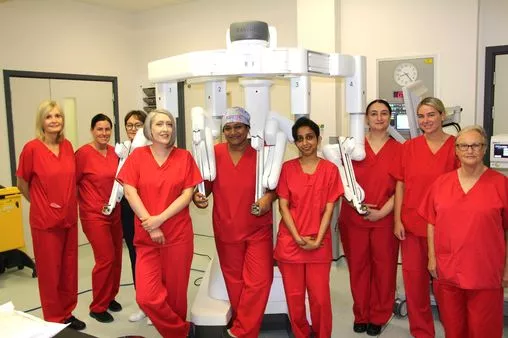Science
North East Hospital Marks 10 Years of Transformative Robotic Surgery

Patients at The James Cook University Hospital in North East England are celebrating the benefits of robotic-assisted surgeries, which have significantly improved recovery times and reduced pain following major cancer operations. The hospital has successfully completed over 1,000 robotic surgeries since it began this innovative approach in 2015. This milestone highlights a decade of advancements in gynaecological cancer treatment, offering patients a less invasive alternative that enhances their quality of care.
The da Vinci X and Xi robotic systems facilitate complex surgeries through a minimally invasive keyhole technique. Surgeons use a computer-assisted interface to maneuver fine instruments, allowing for intricate procedures that were previously challenging. This technology is particularly beneficial for patients with conditions such as ovarian and uterine cancers.
The advantages of robotic-assisted surgery are clear: patients experience smaller incisions, faster recovery times, and less postoperative pain. This method has proven especially advantageous for individuals over the age of 70 who may have multiple health issues. As a result, hospitals can discharge the majority of patients the day after their surgeries, freeing up beds for others and reducing waiting lists.
Before the introduction of robotic techniques, traditional gynaecological cancer surgeries involved large incisions, which often led to extended hospital stays, increased blood loss, and a heightened risk of infections.
Patient Experiences Highlight Success
Two patients, Sue Jeffrey and Annalisa Perry, recently shared their positive experiences after undergoing robotic-assisted surgeries. Sue, a retired council leader, discovered a large lump in her abdomen in December 2024. Given her medical history of breast cancer, she was understandably anxious. After undergoing robotic surgery to remove a cyst, alongside a hysterectomy and appendectomy, Sue was surprised by her swift recovery.
“I was unsure about what robotic surgery was at first but not worried at all because it was all explained very clearly,” Sue said. “It felt amazing to go home the very next day after a major surgery. There were no big dressings or stitches but just five tiny incisions that were sealed with glue.” She expressed gratitude for the care she received, stating, “The care I have received was brilliant.”
Annalisa, a retired chef diagnosed with atypical endometrial hyperplasia in 2020, faced a similar journey. After her biopsy in March 2025 revealed cancer, she underwent robotic-assisted surgery to remove the tumor. “To be honest, I felt no pain on the day of the surgery or after the procedure,” she remarked. Annalisa also emphasized the broader implications of robotic surgery for healthcare, stating it could help save beds and enable more patients to return home quickly.
Future of Robotic Surgery in Healthcare
The NHS 10 Year Health Plan outlines a commitment to integrating digital technologies into healthcare to enhance patient care. Expanding robotic surgery is a fundamental aspect of this initiative, aimed at modernizing services and improving patient outcomes across the UK.
According to Dr. Anupama Rajan Babu, a consultant gynaecologic oncologist at The James Cook University Hospital, robotic surgery allows for greater precision in treating complex cancer cases. “Most patients return to their normal routines much sooner than with traditional open surgery,” she explained. Additionally, the cost savings associated with robotic procedures is significant, estimated at approximately £5,000 per patient.
These advancements not only improve patient outcomes but also alleviate pressure on healthcare resources, allowing hospitals to serve more patients effectively. As the healthcare landscape continues to evolve, the impact of robotic-assisted surgeries at The James Cook University Hospital serves as a notable example of how technology can transform patient care and recovery.
-

 Entertainment3 months ago
Entertainment3 months agoAnn Ming Reflects on ITV’s ‘I Fought the Law’ Drama
-

 Entertainment4 months ago
Entertainment4 months agoKate Garraway Sells £2 Million Home Amid Financial Struggles
-

 Health3 months ago
Health3 months agoKatie Price Faces New Health Concerns After Cancer Symptoms Resurface
-

 Entertainment3 months ago
Entertainment3 months agoCoronation Street’s Carl Webster Faces Trouble with New Affairs
-

 Entertainment3 months ago
Entertainment3 months agoWhere is Tinder Swindler Simon Leviev? Latest Updates Revealed
-

 Entertainment4 months ago
Entertainment4 months agoMarkiplier Addresses AI Controversy During Livestream Response
-

 World2 weeks ago
World2 weeks agoBailey Announces Heartbreaking Split from Rebecca After Reunion
-

 Science1 month ago
Science1 month agoBrian Cox Addresses Claims of Alien Probe in 3I/ATLAS Discovery
-

 Entertainment2 weeks ago
Entertainment2 weeks agoCoronation Street Fans React as Todd Faces Heartbreaking Choice
-

 Health4 months ago
Health4 months agoCarol Vorderman Reflects on Health Scare and Family Support
-

 Entertainment4 months ago
Entertainment4 months agoKim Cattrall Posts Cryptic Message After HBO’s Sequel Cancellation
-

 Entertainment3 months ago
Entertainment3 months agoOlivia Attwood Opens Up About Fallout with Former Best Friend





















